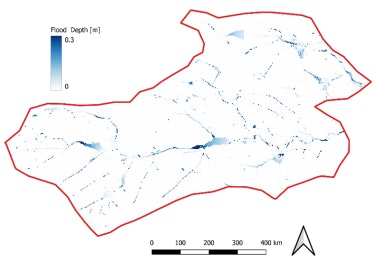Antecedent Conditions and its Incorporation in Previsico’s Modelling
- Written by
 Lauren Legate
Lauren Legate- Published
- August 2, 2023
Weather forecasts alone do not provide enough data to accurately forecast a potential flood event. The occurrence and magnitude of precipitation-induced flood events are driven by a wide range of factors including the antecedent ground conditions i.e. the catchment’s soil moisture. The moisture levels of the soil depend primarily on the antecedent conditions of the flood event. Antecedent conditions play a crucial role in flooding, and hence it is essential to account for them when floods are forecasted. Wet antecedent conditions can lead to significant flooding even if the rainfall during an event is not very intense, prolonged, or widespread. Previsico accounts for the antecedent conditions of an event and is able to simulate flood forecasts incorporating into our model the rainfall and the ground conditions preceding the event and by adjusting accordingly the parameters affected by wetness including drainage capacity and hydraulic conductivity.
Ground conditions are accounted for in Previsico’s model by modelling soil infiltration and also by incorporating data related to the drainage capacity of an area. Both are modified spatially and temporally every time a flood forecast is generated. The spatial distribution of the ground conditions depends on the soil type as well as the land use. The drainage network of an area plays a pivotal role in surface water flooding. It is understood that well designed and maintained networks can reduce (or even eliminate) the magnitude of a flood event. In contrast, poorly designed and maintained drainage networks can largely increase the risk of surface water flooding for an area due to reaching its capacity and not being capable of discharging quickly enough. Previsico incorporates this data into our model and offers clients the ability to share their knowledge and experience of flood so that appropriate adjustments are made if drainage networks in an area do not perform as expected.
In order to account for the temporal processes which dictate the antecedent conditions, Previsico uses a range of data including the accumulated rainfall of the days preceding a forecast. Based on this data, the antecedent conditions are adjusted accordingly as wet conditions can be an indication of ponding water, meaning reduced infiltration rate. Similarly, a drainage network’s capacity is expected to decrease when flooding occurs.
Previsico modelled hydrological catchment in Yorkshire for the event of 7th November 2019 which experienced significant flooding on this date. Three different configurations were tested, and the results can be seen in the graphs below.



In summary, to accurately forecast the risk of a flood event, it is essential to consider not only the forecasted precipitation on the day, but also the antecedent conditions and flow routing across the whole catchment using a model specific to that event. Previsico is underpinned by two decades of published research and continues to use multiple credible data inputs, such as antecedent conditions, to develop its flood forecasting technology to ensure it can provide the most accurate forecasting data to its clients. Incorporating antecedent conditions within our flood modelling is an excellent example of data inputs improving the accuracy of our flood forecasting and the test scenario above displays the difference this data can make to a flood model.
By Dimosthenis Tsaknias, Senior Flood Modeller at Previsico